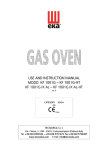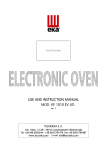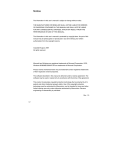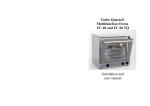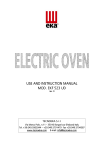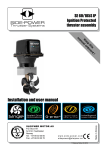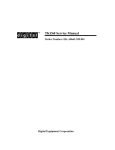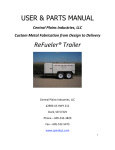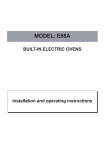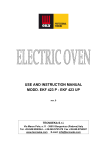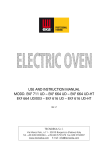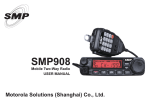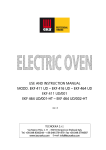Download the User Manual for this product
Transcript
USE AND INSTRUCTION MANUAL MOD. KF 1007 1007G UD rev. 3 CATEGORY GB II2H3+ 0705 TECNOEKA S.r.l. Via I. Nievo, n.12/B - 35012 Camposampiero (Padova) Italy Tel. +39.049.9300344 – +39.049.5791479 Fax +39.049.5794387 www.tecnoeka.com E-mail: [email protected] __ TECNOEKA Srl _________________________________________________________ use and instruction manual _ Prodotti mirati per Ristorazioni, Pasticcerie, Panetterie e Gastronomie TECNOEKA Srl Via I. Nievo, 12/B 35012 Camposampiero (PD) Tel. +39 049 5791479 - +39 049 9300344 Fax + 39 049 5794387 www.tecnoeka.com – [email protected] CE DECLARATION OF CONFORMITY Annexed document II A, of directive 2006/ 2006/42/E 42/EC /EC Manufacturer Address TECNOEKA Srl Via I. Nievo, 12/B - 35012 Camposampiero (Pd) Type of product Model Convection gas oven KF 1007G 1007G UD TECNOEKA Srl declares that the above mentioned products conform to the safety regulations under: CEI EN 60335-1 - Low voltage directive 2006/95/EC CEI EN 60335-2-42 - Electromagnetic compatibility Directive 2004/108/EC CEI EN 55014-1 CEI EN 55014-2 CEI EN 61000-3-2 CEI EN 61000-3-3 CEI EN 61000-4-2 CEI EN 61000-4-4 CEI EN 61000-4-5 CEI EN 61000-4-6 CEI EN 61000-4-11 - Gas Appliances directive 2009/142/EC Machine Directive 2006/42/EC; Directive on the general safety of products 2001/95/EC; Directive on the restriction in the use of dangerous substances in electrical and electronic appliances 2002/95/EC; - Directive on waste from electrical and electronic appliances 2002/96/EC. Camposampiero, 30/05/2012. ___________________ Signature of a Representative of the Board of directors X:\Sgq\PRODOTTI\Fam. 1 - FORNI\FORNO GAS\LEka\MANUALI D'USO - Forno gas - LEka\Lingua inglese\Instruction manual KF 1007G UD - GB - rev.3.doc _ page. 2 ________________________________________________________________________________________ _ Convection gas oven _ rev. 3____________________________________________________ MOD. KF 1007G UD _ Index 1 Descriptions and general warnings 1.1 1.2 1.3 2 General instruction (for installation technician) 2.1 2.2 2.3 2.4 2.5 2.6 2.7 2.8 2.9 2.10 2.11 2.12 2.13 3 Place of installation Transporting the oven Unpacking the oven Removing the protective film Disposing of the packaging Positioning Gas connection Electrical connection Connection to water mains Water outlet Thermal breaker safety devices Electronic circuit protection Disposing of the oven StartStart-up (for installation technician) 3.1 3.2 3.3 3.4 4 General warnings Data-plate and warning-plate Technical specifications Check of nominal thermal capacity Check of connection pressure Adaptation to other gas Injector replacement and adjustment of primary air User instructions 4.1 4.1.1 General information 4.2 4.2.1 4.3 4.3.1 4.3.2 4.3.3 4.3.4 4.3.5 4.3.6 4.4 4.5 4.6 4.7 4.7.1 4.7.2 Operating instructions Control panel Operation mode Cooking cycle ON/OFF Displaying / changing parameters with the cooking cycle ON Programmed mode Saving cookin programs Cooking with a saved program Cooking with the “temperature at heart” function (for prepared ovens) Door device Black – out First ignition Cooking techniques Steam cooking (moist heat) Convection cooking (dry heat) Residual risks ________________________________________________________________________________________ page. 3 _ __ TECNOEKA Srl _________________________________________________________ use and instruction manual _ 4.7.3 5 6 Convection + humidity cooking (dry heat + moist heat) Cleaning 5.1 5.2 General information Cleaning the cooking chamber 5.3 5.4 5.5 5.6 5.7 Cleaning the fans Cleaning the door seal Cleaning the door Cleaning the external casing Periods without use Maintenance 6.1 General information 6.2 6.3 6.4 6.5 6.6 Changing the lighting lamp in the cooking chamber Changing the door seal Resetting the thermal breaker safety device Possible faults Wiring layout 7 TECHNICAL ASSISTANCE AND ORIGINAL ORIGINAL SPARE PARTS 7.1 Spare parts list 8 Informations to the consumers 9 The Warranty _ page. 4 ________________________________________________________________________________________ _ Convection gas oven _ rev. 3____________________________________________________ MOD. KF 1007G UD _ 1. Description Description and general warnings The model convector oven bears (KF 1007G UD) an official CE mark, issued by a Notified Body, entrusted with and responsible for evaluating the observance of the essential requirements specified by Gas Directive 90/396/EEC. The oven and the quality of the production system are subjected to regular surveillance by means of inspection checks in order to ascertain their conformity to the type certificate specified by the above mentioned Directive. This appliance may be marketed in all the European countries whose abbreviated reference is present on the technical data-plate. The appliance must be installed to conform with the local laws on the installation of electrical-gas appliance for collective use, and shall include the accessories and functional adaptations required in the destination countries, which are described in the original language in the use and maintenance handbook. The oven has an atmospheric burner and a heat exchanger for heating the cooking compartment. Heat is diffused by an internal two-way fan. The parameters relative to cooking (times, temperatures and climate) you set electronically and appear on the digital display. It is possible to get steam inside the oven chamber. If the burner doesn’t switch on, a red block light: it is possible to restart safely the ingnition of burner through the reset button. If the oven chamber overheats, a safety thermostat blocks the gas delivery and the power to the oven is cut off; it will be possible to switch it on again only manually. The device is located on the rear of the unit. 1.1 General warnings - If, on receipt of the goods, the packaging is damaged, write the following on the delivery note: “I REVERSE THE RIGHT TO CONTROL THE GOODS”, GOODS” specify the damage and get the driver to sign in acceptance; send a claim in writing to the seller within 4 calendar days from the date of receipt. No claim shall be accepted after such period. - Read this handbook carefully: it supplies information on safe use, installation and maintenance. The purpose of this manual is to provide information to operators on the essential prescriptions and criteria to ensure their own safety and prolong the oven’s operating life. This manual must be read by all personnel authorised to work on the machine before it is started up. It must be stored together with the machine for all future consultation. If the manual becomes worn or is mislaid, ask for another copy directly from the manufacturer. These instructions are valid only for countries whose abbreviated reference appears on the cover of this manual and on the data-plate. In European countries where marketing is possible, manuals in the official language shall be provided with specific references to gas, pressures, categories and conditions for the connection. In European countries where marketing is possible, manuals in the official language shall be provided with specific references to gas, pressures, categories and conditions for the connection. - Maintenance, adaptation to another type of gas, installation, and the functional check must be performed only by qualified personnel authorised by the manufacturer. Install the appliance in a suitable ventilated room and put it into operation while observing the laws in force. Insist on original spare parts and, after replacing and/or adjusting a part, such as primary air, make sure that it is sealed with paint to prevent any tampering. We advise you to take out a maintenance contract. - This appliance is designed for cooking or heating foods. Do not use it for other purposes; all other uses are considered improper. The appliance is intended for collective and professional use and must be utilised by personnel trained to use it. - Before every oven cleaning or maintenance job, switch off electrical power, and shut off gas and water supplies. N.B.: Improper or incorrect use and failure to observe the installation instructions shall release the manufacturer from all responsibility. ________________________________________________________________________________________ page. 5 _ __ TECNOEKA Srl _________________________________________________________ use and instruction manual _ 1.2 Technical datadata-plate and warningwarning-plate The technical data-plate (Fig.1) and the plate with the installation warnings (Fig. 2) are permanently and visibly fitted on the rear panel of the oven. An additional plate – to be removed with all packing material – is situated inside the packing. Fig. 1 GB; S.N.; Fig 1 DE “Dieses Gerat muß nach geltenden Vorschriften angeschlossen und darf nur in einem gut belufteten Raum betrieben werden. Bitte beachten Sie vor Inbetriebnahme des Gerates die Gebrauchs- und Wartungsanleitung.“ FR “L’appareil doit être raccordé conformément aux normes en vigueur et il ne doit être installé que dans locaux bien aérés. Faire attention aux instructions relatives á l’utilisation et l’entretien de l’appareil avant de le mettre en marche.“ ES “El apparato debe ser conectado conforme a las normas vigentes y se tiene que instalar solo en locales bien aireados. Prestese especial atencion a las instrucciones para el luso y mantenimiento del apparato antes de ponerlo en marcha.” GB “The appliance must be connected according to the standards in force and must be installed only in well aired premises. It is recommended to follow the use and servicing instructions of the appliance before operating it.” PT IT O aparelho deve ser ligado em conformidade com as normas vigentes e deve ser instalado somente em locais bem ventilados. Deve-se prestar particular atenção às instruções para o uso e a manutenção do aparelho antes de pô-lo em funcionamento. "L'apparecchio deve essere allacciato conformemente alle norme in vigore e deve essere installato solo in locali ben aerati. Si presti particolare attenzione alle istruzioni per l'uso e la manutenzione dell'apparecchio prima di metterlo in funzione." Fig. 2 _ page. 6 ________________________________________________________________________________________ _ Convection gas oven _ rev. 3____________________________________________________ MOD. KF 1007G UD _ 1.3 Technical specifications Model KF 100 1007G UD External overall dimension L x D x H Weight Oven dimension L x D x H Oven operational volume Nominal thermal capacity Tray maximal load (GN1/1) Total load (10 trays GN 1/1) ISO 7-1 gas union Water union Fume exhaustion vertical tube Appliance category (for United Kingdom) Factory adjustment Type of construction Electrical power Electrical capacity Class Power cable type 965 x 885 x 1095 mm 148 Kg 604 x 458 x 608 mm 168 dm3 13 kW 4 kg 28 kg 1/2 “ 3/4 “ Ø 150 mm; height min. 500 mm II2H3+ Methane gas G20 a 20 mbar A1 / B11 220-230 V ~ 1,15 kW I H07RN-F 3 x 1,5 mm2 Connecting electric cable Type Y Gas connection pressure Water connection pressure Gas consumption calculated at low heat value of Hi at 15° and 1013 mbar Liquid butane/propane gas G30/G31 : 30/37 mbar Methane gas G20: 20 mbar Max. 250 kPa (2,5 bar) G30 : 1,03 kg / h G20 : 1,38 m3 / h Parameters to the chimney B11 (Ø 150 mm, L=0,5 m) (G20 20 mbar) fume load 25.5 g/s fume temperature 220 °C Parameters to the chimney B11 (Ø 150 mm, L=0,5 m) (G30 28-30 mbar) fume pressure fume load -1.4 Pa 24.2 g/s fume temperature 231 °C fume pressure G 30/G 31 : 190 1/100 mm G30/G 31 : 16 mm -1.5 Pa G 20 : 270 1/100 mm G 20 : 10 mm Main injector diameter Primary air bush adjustment Table 1 2. General instruction (for installation technician) The installation technician must make sure that start-up conforms to current national regulations. The appliance must be installed only by qualified personnel authorised by the manufacturer. She must observe the safety regulations in force in the country where the appliance is installed. All extraordinary maintenance jobs (possible adaptation to another type of gas or replacement of parts) must be performed by qualified personnel having the necessary professional qualifications. The manufacturer will not respond for damage to people, animals and property due to installation errors. Likewise the manufacturer is not responsible for breakage caused to the appliance by incorrect installation. 2.1 Storage If the appliance has been stored in a warehouse at a temperature below 0°C (min. allowed is –20°C), it should be brought to a temperature of at least +10°C before it is turned on. ________________________________________________________________________________________ page. 7 _ __ TECNOEKA Srl _________________________________________________________ use and instruction manual _ 2.2 Transporting the oven During transport, the appliance must be left in its original wooden cage to protect it against damage. 2.3 Unpacking the oven Remove all the packaging before installation, which is formed of a wooden cage that holds the appliance and cardboard casing to protect it. Check that the appliance has not been damaged during transport and if any damage is discovered immediately inform your retailer and/or the haulier. 2.4 Removing the protective film Before using the appliance, carefully remove the special protective film over the stainless steel parts, without leaving any glue residue on the surfaces. If necessary, remove the residue at once with a suitable non-inflammable solvent (e.g. acetone). 2.5 Disposing of the packaging The packaging must be disposed of in accordance with current legislation in force in the place where the appliance is installed. The various types of materials (wood – paper – cardboard – nylon – metal staples) used for the packaging must be separated and delivered to the specific waste disposal centres. In all circumstances the environmental protection regulations must be strictly adhered to. 2.6 Positioning Positioning Check the place where the appliance will be installed to ensure that the passages (doors and corridors) are wide enough (the appliance measurements are given in Fig. 3). The appliance must be installed in a well ventilated room with permanent ventilation openings – if possible, it should be placed under an exhaustion hood ensuring complete evacuation of burned gasses produced during baking. Locate the oven on a table or similar support. We advise to use the support given by the manufacturer; otherwise you must consider the weight of the oven. Never on the floor. For easier access and to allow the air to circulate freely around the appliance, leave at least 50 cm between the left side and the wall (or other appliances), and at least 10 cm between the back and the wall and the right side and the wall (see Fig. 3). The natural ventilation that is needed to ensure efficient working for the oven is through the openings on the walls of the outer covering (left side and back). Consequently, it is strictly forbidden to obstruct these aeration openings, even partially and even for short periods. Failure to observe this specific specific prohibition, shall release the manufacturer from all liability for the appliance and shall immediately cancel any guarantee rights for the said appliance, because its constructive conformity has been voluntarily compromised. For the same reason, do not position equipment with a source of heat on the left hand side of the oven; in fact if ambient temperature on that side becomes too high, the oven switches itself off for safety reasons If the appliance is installed near walls, tops, shelves or other similar items, they must not be inflammable or sensitive to heat, otherwise they must be protected by a suitable fireproof covering. In all cases, all fire prevention standards must be strictly adhered to. With regards to the methods of discharging combustion fumes and in compliance with the provisions of the local legislation for the installation of gas equipment, this oven can be classified and therefore installed as follows: Type A1 Installation: drawing the comburent air and discharging flue gases directly into the installation room. This installation requires the working environment to be kept wholesome by emptying the foul air and drawing fresh air through wall fans or extraction equipment. _ page. 8 ________________________________________________________________________________________ _ Convection gas oven _ rev. 3____________________________________________________ MOD. KF 1007G UD _ Type B11 Installation: discharging the flue gases out of the installation room with a draughtdiverter compatible with a vertical tube (diam. 150 mm) making the discharge of the flue gases into the extraction unit or directly into the building flue easy. Since flue gases can reach high temperatures, pay particular attention not to overheat any temperature sensitive elements (extraction equipment filters, electrical cables, etc.). For the details regarding the installation (for instance minimum sections of ventilation, storing of the gas canisters, etc.) see the applicable regulations in force in the country of destination. Pay particular attention so that the volume of air required for the combustion is not obstructed in any way by objects placed under or around the unit. The flow of air required to ensure the correct combustion and the adequate change of air in the working place can be determined with the following formula: Q = 35 x P (where Q = air flow in m3 and P = heat input in kW). If other equipment is fed with gas, the openings to ventilate the room must be enlarged as a consequence. 2.7 Gas connection Before installing, make sure that the oven is designed for use with the available gas. If it is not, consult paragraph “Adaptation to other gas” or contact the manufacturer’s technical assistance service. Connection to the gas mains must be made according to the current national norm and subsequent amendments. The oven gas connection is R 1/2; this entry section must not be reduced. Connection to the gas supply line must be made by using rigid or flexible pipes, exclusively in metal, with diameters in proportion to the power of the appliance and the length of the pipe route. Make sure that the pipe does not pass close to the hot areas and that it is not subjected to torsion and traction stresses. Install a rapid ON/OFF tap between the gas mains and each appliance, in a position facilitating tap opening and shutting operations. After installing the appliance, run a tightness test on the entire gas circuit, using a leak-detector spray or other non-corrosive foam generating substances (do not use flames for this operation). The unions of the copper pipes must be made by using mechanical couplings without seals. 2.8 Electrical connection Connection to the electrical mains must be made according to the current legal regulations. Before making the electrical connection, make sure that the voltage and frequency shown on the rating-plate match those of the electrical supply system and that the latter is provided with an efficient earth connection. The power cable used must not have lower characteristics than: rubber insulated type H07RN-F with diameter of 3 x 1,5 mm2. If connection to the electrical mains is permanent, a multi-core protective switch of adequate capacity must be installed, with contact opening distance of the overvoltage category III (4000 V).. The yellow/green earth wire must not be disconnected by the switch. If the supply cable is damaged then it must be replaced by the manufacturer or by your technical support or by a qualified person to avoid any risk. The appliance must be part of an equipotential system - this connection is obtained with the stop screw marked with the symbol located at the rear. The diameter of the equipotential wire must be 2,5 mm2. When the appliance is operating, the supplied voltage must not deviate from the nominal voltage value of ± 10%. To replace the cable, cut off electrical power, and access the terminal board by removing the oven rear panel. Locate the cables so that the earth conductor is the last to detach from its terminal in the event of reverse pulling. Use an electrical cable with characteristics not below to those mentioned above. ________________________________________________________________________________________ page. 9 _ __ TECNOEKA Srl _________________________________________________________ use and instruction manual _ Installation / connection layout Fig. 3 (Dimensions in mm.) _ page. 10 ________________________________________________________________________________________ _ Convection gas oven _ rev. 3____________________________________________________ MOD. KF 1007G UD _ 2.9 Connection to water mains The oven must be supplied with softened drinking water (see the respective signal next to the connection solenoid-valve), with a hardness value of 0,5 to 5°F (it is mandatory using a water softener to reduce the formation of scaling inside the boiler). The water pressure must be in the range of 150 to 250 kPa (1,5 – 2,5 bar). If the water pressure exceeds 2,5 bar, install a pressure reducer device upstream. If the pressure is below 1,5 bar, use a pressure pump to increase the level. The connection to the water supply is done using the ¾” threaded solenoid valve on the back (at the bottom) of the appliance (see fig. 3), fitting a mechanical filter with a cut-off cock (before connecting the filter, allow a certain amount of water to flow out in order to remove any waste from the pipe). 2.5 cm min. 30cm 2.10 Connection Connection Water outlet There is a drainage pipe on the back of the appliance (see Fig. 3) for emptying the cooking chamber. A pipe of at least 30 mm internal diameter (DN30) must be connected to this pipe that is resistant to the steam temperature. To avoid throttling, we advise using a rigid pipe without any elbow bends along its length. The pipe must have a constant inclination of at least 5% along its length (the length is that from the outlet pipe from the appliance to the drain and must not exceed 1 meter overall). The outlet pipe must flow into an open drain on the floor (Fig. 4). If not, there must be a difference in height between the outlet pipe on the appliance and the drain of at least 30 cm (see Fig. 5) to ensure the water flows out correctly. Moreover the minimum “air drop” must be 25 mm (distance between the discharge pipe coming from the unit and the exhaust pipe socket). In conformity with hygiene regulations in force, the pipe connected to the water outlet pipe on the appliance must not be directly in contact with the outlet point. max. 2 mt max. 2mt Fig. 4 Fig. 5 2.11 Thermal breaker safety devices The appliance is supplied with a manually resetting thermal breaker to protect against excessive, dangerous temperatures which could be accidentally generated inside. If it is tripped, the device cuts off the power supply to the appliance. The device is located on the back of the unit and is identified by a suitable label (Fig. 3). The reset button can be activated after unscrewing the black plastic cover and letting the oven cool down 2.12 Electronic circuit protection The electronic circuit inside the electric components compartment is protected by fuse. 2.13 Disposing of the oven The oven is made with recyclable raw materials and does not contain any toxic substances hazardous to people or the environment. Its disposal, as well as the disposal of its packaging, must be carried out in compliance with the regulations in force in the place where it is installed. The different materials that make it must be divided into types of disposal and given to the ________________________________________________________________________________________ page. 11 _ __ TECNOEKA Srl _________________________________________________________ use and instruction manual _ appropriate collection centres. Follow the regulations regarding the protection of the environment at all times 3. STARTSTART-UP (for installation technician) technician) 3.1 Check of nominal thermal capacity The nominal thermal capacity must be verified by an authorised technician or by the gas supply Body, observing the information in this use manual. This check must be performed for new installations, adaptation to another type of gas and during all extraordinary maintenance jobs. There is no other possibility of adjusting the nominal thermal capacity – this is done by measuring correct connection pressure and checking if the injector being used is of appropriate diameter. The nominal thermal capacity is controlled by using a gas meter and a chronometer. The exact volume of gas that must flow through per time unit can be obtained from the technical specifications table. This value must be maintained in the specified range, the permissible tolerance being ±5%. 3.2 Check of connection pressure pressure (Fig. 6) 6) The connection pressure is measured, with the unit working, using a pressure gauge for liquids (for instance a liquid-level gauge with a minimum resolution of 0,1 mbar). To carry out this test, remove the back of the unit and connect the “T” hose of the “M” gauge to the “P” inlet pressure tapping point of the gas solenoid valve, after unscrewing the tapping point screw. Measure the connection pressure: if this value is not in the range shown in table 2 and it cannot be brought within these values by adjusting the pressure reducers of the gas supply system, definitive start-up of the appliance is quite impossible. The gas supply Body must be informed about this.. Type Type of gas Methane gas H G20 LPG gas G30/G31 Gas pressure (mbar) Normal Minimum Maximum 20 17 25 30/37 20/25 35/45 P P re ssio ne H2 mm O 1100 1000 900 800 T 700 600 500 400 M 300 Key: T = Hose M = “U” pressure gauge P = Pressure taketake-off at entry of gas solenoidsolenoid-valve Table Table 2 Fig. 6 After you have measured the connection pressure, disconnect the hose “T” and screw the tightness screw of the pressure take-off “P”. 3.3 Adjustment to Other Gas To adapt the oven to a type of gas that differs from the one tested in the factory (see technical data plate), replace the injector of the main burner and adjust primary air inflow with the adjustment bush. For this, disconnect the power and, after removing the back panel, access the burner and the primary air adjuster. If you do not have the necessary spare parts, contact the manufacturer’s technical assistance service. Adaptation must be effected by qualified personnel. Consult the technical specifications in table 1 and 3, and then replace the main injector and adjust primary air. 3.4 Injector replacement and adjustment of of primary air (Fig. 7) WARNINGS! WARNINGS! Before you attempt this operation, make sure you shut off the gas ON/OFF tap located upstream of the appliance and disconnect electrical power to the appliance. After removing the back of the unit, carry out the following operations in series: _ page. 12 ________________________________________________________________________________________ _ Convection gas oven _ rev. 3____________________________________________________ MOD. KF 1007G UD _ - Loosen the “V” locking screw with a spanner or a screwdriver and pull out bush “B“ towards the burner Venturi pipe. Using a 13 mm wrench, unscrew and replace injector “U” with the appropriate injector for the new type of gas installed, referring to table 3 and checking if the diameter is stamped on it. Adjust air bush “B” to the correct distance H, which is the distance in millimetres between the flat seat of the injector-holder and the adjustment bush. Seal the screw and bush with paint. Refit the back of the unit. U V B T H Gas G30/G31 G20 Pressure 30/37 mbar 20 mbar Injector diameter 190 190 1/100 mm 270 1/100 mm Distance H 16 mm 10 mm Table 3 Key: B = Primary air bush T = Burner Venturi tube U = Injector V = Bush securing screw Fig. 7 WARNINGS! After every adaptation to a new gas, make sure of the following: - Using an indelible adhesive, apply the data referring to the new installation on the technical data-plate. - Run the appropriate tightness tests on the gas circuit. 4. USE INSTRUCTIONS INSTRUCTIONS (for the user) ATTENTION!: - The appliance is in tented for professional use and must be utilised by personnel trained to use it. - All ordinary maintenance and repair jobs must be carried out strictly by qualified personnel. - All installation, setset-up and maintenance operations must be carried out strictly by installation technicians authorised by the manufacturer, observing the current national regulations. regulations. - We advise you to have the appliance periodically controlled by a specialised technician in order to keep it perfectly efficient – to this end, you are recommend to sign a maintenance contract. 4.1 General Information - When using the oven for the first time, we advise you to run it load-free at maximum temperature for about one hour. In this way, any unpleasant smells, due to thermal insulation, and grease residue from assembly are eliminated. - Make sure that nothing prevents air from flowing into the burner and, in general, into the ventilation of the room. Do not obstruct the burned gasses outlet or the oven flue, and do not place any objects over these points. - Check regularly the efficiency of the extraction unit, the exhaust pipes and the building flue (no soot for instance). ________________________________________________________________________________________ page. 13 _ __ TECNOEKA Srl _________________________________________________________ use and instruction manual _ Survey the oven while it is in operation Shut the gas and water ON/OFF taps upstream and disconnect electrical power when you have finished using the oven. - This appliance must be exclusively used for the purposes for which it was expressly designed, i.e. cooking foods in the oven, any other use is improper. The oven can be used for all oven cooking of pastry, bakery and gastronomy products, fresh and frozen, for re-conditioning refrigerated and deep frozen foods, for steam cooking meat, fish and vegetables. When placing food in the cooking chamber, allow a space of at least 40 mm between pans to avoid over-obstructing the airflow. Do not use pans with edges higher than necessary: the edges act like barriers preventing circulation of hot air. Pre-heat the oven before each time it is used to guarantee the best performance. For the cooking to be as even as possible, place the food evenly in each pan, considering the size of the pieces, layers or the thickness. Do not salt the food when it is in the cooking chamber. To check the cooking cycle is proceeding correctly use the internal light in the chamber do not open the door if it is not necessary, to avoid wasting energy and prolonging cooking times. Do not tamper with the devices sealed by the manufacturer; any tampering is forbidden and dangerous. The misuse of this unit and partial or total failure to follow these instructions release the manufacturer from all responsibilities for any damage to property or injury to people. - - - - 4.1.1 Residual risks After a cooking operation, open the door cautiously, to avoid a violent outflow of heat which could cause burns. While the oven is in operation, pay attention to the hot zones (marked on the appliance) of its external surfaces. The bench or support must be able to support the weight of the machine and house it correctly. The appliance contains electrical parts and must never be washed with a jet of water or steam. The appliance is electrically connected: before attempting any cleaning operation, cut power to the appliance. To prevent incorrect connection of the appliance, the relevant electrical, gas and water connections are marked by identification plates. _ page. 14 ________________________________________________________________________________________ _ Convection gas oven _ rev. 3____________________________________________________ MOD. KF 1007G UD _ 4.2 Operating instructions 4.2.1 4.2.1 Control panel 1 1. Display 2. Parameter setting knob 3. Parameter selection knob 2 4. led showing that parameter is active 5. Key “reset” gas 6. button to save programs 3 7. Key “ON / OFF” 4 5 6 7 4.2.2 .2.2 First ignition When the oven is electrically powered for the first time, "ER2" appears on the control panel display accompanied by a brief acoustic "BEEP". This way the oven warns the user that the “heart” probe (“needle” probe) is not connected to the relevant socket (for specifically designed ovens), thus the temperature value cannot be regulated. The message disappears when the “ON/OFF” button is pressed ON and the selected parameter value (“zero”) appears (Led on next to the relevant symbol). If the selector is turned to “0”, “OFF” appears on the display. If electrical power is constant, the oven is turned on and off normally with the "ON/OFF" button. ________________________________________________________________________________________ page. 15 _ __ TECNOEKA Srl _________________________________________________________ use and instruction manual _ 4.3 Operation mode The cooking cycle can be run in “manual” or “programmed” mode. Each cycle is made up of several cooking parameters: time/temperature/humidity/”heart” temperature (for specifically designed ovens)/half motor speed/half power. MANUAL MODE To select cooking parameters, turn the selector to the selected parameter (see symbol). To set or change the selected parameter value, rotate the regulator knob clockwise (to increase) or counterclockwise (to decrease). ) can be set from 0 hours and 1 minute to 9 hours and 59 The “time” parameter (symbol minutes. If "INF" appears on the display this mean the timer is not set and the oven will operate continuously until manually turned off by pressing the "ON/OFF" button. The “temperature” parameter (symbol ) can be set from 50° C to 270° C. The “humidity/steam” parameter (symbol ) can be set from 1 to 10 (10=100%). The “temperature at heart” parameter (symbol designed ovens). ) can be set from 0° C to 100° C (for specifically IN ORDER FOR THE “TEMPERATURE AT HEART” PARAMETER TO WORK, IT MUST BE SET BEFORE BEFORE THE COOKING COOKING CYCLE STARTS, AND THEN, BEFORE YOU SET THE TEMPERATURE TEMPERATURE PARAMETER IN THE COOKING CHAMBER CHAMBER. AT LEAST COOKING TIME AND TEMPERATURE PARAMETERS PARAMETERS MUST BE SET FOR FOR THE COOKING CYCLE TO START. 4.3.1 Cooking cycle ON/OFF When the door is closed, the cooking cycle automatically starts 5 seconds after setting the two parameters required for cooking (time/temperature). The lights in the cooking chamber, the resistance and motors turn on. When the set cooking cycle time has elapsed, the oven automatically turns off, the set parameter values clear on the display and an acoustic signal sounds for 3 seconds. The oven readies for new cooking cycle settings. The cooking cycle can be stopped at any time by pressing the “ON/OFF” button “OFF”. The display turns off and an acoustic signal sounds for 3 seconds. 4.3.2 Displaying / changing parameters with the cooking cycle ON When the cooking cycle is on, parameters can be displayed by turning the selector knob to the relevant symbol. Parameters can be changed by turning the regulator knob. - “Time” parameter The cooking cycle count down is displayed (blinking led on symbol - “Temperature” parameter The set value (fixed led on symbol ). ) is displayed for 3 seconds alternated by the value measured inside the cooking chamber for 3 seconds (blinking led on symbol - “Humidity/steam” parameter The set value is displayed (fixed led on symbol - “Temperature at heart” parameter The set value (fixed led on symbol read inside the food for 3 seconds. ). ). ) is displayed for 3 seconds alternated by the value “AT HEART” TEMPERATURE CANNOT BE BE SET OR CHANGED WHEN WHEN THE COOKING CYCLE IS ON. It can only be displayed if the "needle" probe (connected to the specific socket) is inserted in food. For the user’s convenience, when the selector is turned to “O”, the cooking cycle count down will be displayed for 3 seconds alternated by the temperature measured in the cooking chamber for 3 seconds. _ page. 16 ________________________________________________________________________________________ _ Convection gas oven _ rev. 3____________________________________________________ MOD. KF 1007G UD _ 4.3. 4.3.3 3.3 Programmed mode Up to 10 cooking programs (cycles) can be saved. Each program can be made up of several cooking parameters. 4.3. 4.3.4 3.4 Saving cookin programs Following the steps below to save a cooking program (with the oven on: “On/Off” button pressed): Leave the oven door open (to prevent parameter settings from automatically starting the cooking cycle). Set the relevant cooking cycle parameters following the same procedure used for “manual” mode. Turn the selector to “o” (“oFF” appears on the display). Turn the regulator knob and select the required program number (from P01 to P10). - Press and hold down the “ ” button for at least 5 seconds: the program is successfully saved with the saved program number blinks on the display. The saved program and cooking cycle start when the oven door is closed. To cancel a saved program, simply replace it with a new program (with the same number) where new parameters are set for the new cooking cycle. The new program must be saved by pressing the “ ” button. 4.3. 4.3.5 3.5 Cooking with a saved program Following the steps below to recall a cooking program (with the oven on: “On/Off” button pressed): - Turn the selector to “O” (“oFF” appears on the display). - turn the regulator knob and select the required program number. If the door is closed, the cooking cycle automatically starts 5 seconds after the program number is selected. When the oven is operating in “programmed” mode, set parameters can be displayed in the same way as with “manual” mode. For the user’s convenience, set parameters can be changed during oven operations in “programmed” mode. At the end of the programmed cooking cycle, changed parameters are automatically “RESET” and return to the values initially saved in the program. 4.3. 4.3.6 3.6 Cooking with the “temperature at heart” function (for prepared ovens) The temperature can be set inside the core of the food to be cooked, using the special needle core probe. The probe must be pushed into the centre of the food in the thickest part, avoiding the bones. Place the food inside the cooking chamber and pull out the thermal probe lead and close the oven door. The probe plug must be plugged into the special socket (see Fig. 1) at the bottom of the control panel. When the "at heart" probe is turned on during the cooking cycle, turning the selector to the "time" parameter (symbol ), "Prb" will appear on the display (confirmation that the “at heart” probe is on). For the user’s convenience, turn the selector to “O” and "Prb" will be displayed for 3 seconds alternated by the temperature measured in the cooking chamber for 3 seconds. The cooking cycle ends as soon as the temperature read by the “needle” probe (inserted in food) reaches the value set in the “temperature at heart” parameter (regardless of the value set in the “time” parameter). The oven automatically turns off, the set parameters reset on the display and an acoustic signal sounds for 3 seconds. The oven readies for a new cooking cycle. Warning: Before removing the food from the oven after cooking with the core needle probe. Warning Carefully remove the hot probe from the cooked food, taking care not to leave it hanging out of the cooking chamber as it could cause burns. We advise leaving it to cool down before using it again – to avoid damaging pricks in the food. ________________________________________________________________________________________ page. 17 _ __ TECNOEKA Srl _________________________________________________________ use and instruction manual _ To prevent any irreparable damage to the thermal piercing probe (core probe) do not use it in high temperature cooking ABOVE 230°C, and ensure that the probe lead is not touching any hot metal surfaces inside the oven. 4.4 Door device The device stops oven operations (stops the cooking cycle) whenever the door is opened. The cooking cycle resumes where it left off when the door is closed. 4.5 Black - out When power returns after a black-out, the oven automatically resumes operations and the cooking cycle resumes from where it left off. 4.6 First ignition The oven can be used for the first time only after the chamber has been carefully cleaned with a special detergent for stainless steel. The detergent must not contain acid substances (chloride acid, bleach, etc.) or be abrasive. Alternatively the chamber can be washed with warm soapy water or warm water and a drop of vinegar. Rinse well and dry with a soft cloth. First ignition (without food inside the oven) serves to eliminate any unpleasant smells (which are quite normal) due to the thermal insulation heating up that covers the cooking chamber and any oil residues from assembly of the metal parts. After turning the power on (close the unipolar switch fitted upstream from the appliance), and the water (open the interception cut-off cock), proceed as follows (see the figure of the control panel): - press the on/off push button;; - set the time (knob on the symbol ) at one hour (shown on the display); - set a temperature (knob on the symbol ) of 270°C for the cooking chamber (shown on the display); - check the door is closed; - the cooking chamber starts automatically to heat up after 5 minutes when the temperature is set. When the time is up, the oven turns off automatically and the beeper sounds for 03 seconds.. 4.7 Cooking techniques There are three different cooking techniques: steam, convection and convection & humidity. 4.7.1 Steam cooking (moist heat) The climate regulation system which allows dividing the humidity production which should be set at 10 (humidity \ continuous steam) , while the cooking chamber temperature can be set between 105°C and 115°C. Steam cooking is indicated where a boiled effect is required, and it has the advantage of leaving the nutritional content of the food unaltered (the vitamins and flavour of the food are conserved), the outer appearance (the colour is conserved, no lumps or air bubbles are formed and the surface does not break up) and the weight is conserved, as no liquids are lost from the food during cooking. 4.7.2 Convection cooking (dry heat) The heating elements heat the dry air inside the cooking chamber. This heated air is evenly distributed by the high speed of the fans. This gives an even temperature throughout the cooking chamber and even cooking even when the oven is full. This means that different types of food can be cooked on the various shelves (as long as they need the same cooking temperature) without flavours and smells being mixed together. The cooking chamber temperature can be set between 50°C and 270°C. _ page. 18 ________________________________________________________________________________________ _ Convection gas oven _ rev. 3____________________________________________________ MOD. KF 1007G UD _ Besides evenly browning the food without having to turn it, convection cooking can be used to cook au gratin and is particularly convenient for rapid defreezing, for sterilising preserves and drying mushrooms and fruit. 4.7.3 Convection + humidity cooking (dry heat + moist moist heat) This type of cooking exploits the combination of dry and moist heat. The climate regulation system which can divide the production of humidity (set from 1 to 10 depending on the request). The cooking chamber temperature can be set between 50°C and 270°C. The fact of using a hot-moist climate inside the cooking chamber is the most convenient and efficient way of cooking: cooking times are reduced, the surface of the foods remains soft and does not form a crust, there is little weight loss and the fatty mass is reduced. The special hot-moist climate at low temperatures is ideal for re-conditioning food. 5. Cleaning 5.1 General information Before beginning any sort of cleaning work on the appliance, turn the power supply off (at the magnetothermal safety switch) and the water supply (by closing the cut-off cock) and then let the oven cool down completely. The appliance must be cleaned frequently, preferably daily, to guarantee best operations and long life. The oven is equipped with electrical components therefore for obvious reasons water should not be used in excess for cleaning. However, it is absolutely forbidden to wash the appliance with water jets, especially if they are pointed towards the aeration vents on the metal surface of the outside casing (this could cause dangerous infiltrations that would damage the electric parts). If grease remover detergents are used to clean the stainless steel, ensure they do not contain corrosive acids (no sort of chlorine, even if it is diluted) or abrasive products. Follow the indications given on the product and the warnings about its use, wearing rubber gloves during cleaning. Do not use iron pads, steel wool or scrapers as they would ruin the surfaces. Do not leave food on the steel surfaces for a long time that contain acid substances (lemon juice, vinegar, salt, etc.) as they could cause corrosion. 5.2 Cleaning the cooking chamber For hygienic reasons, it is good practice to clean the cooking chamber at the end of each cooking cycle, otherwise it should be cleaned at least once at the end of each day’s use. For easier cleaning, remove the side grills by unscrewing the 4 fixing screws (hold the reeded nut between your thumb and forefinger and turn it in an anti-clockwise direction) and please carry out the following operations: - spray a special degreasing product for stainless steel on the external walls, on the fan casing (do not spray it through the fan grids) and on the glass inside the door; - leave the product to work for approximately 20 minutes with the door closed; - turn the oven on to 70-80°C; - run a cycle with maximum steam (knob “humidity\steam on 10) for around 15 minutes; - when the cycle is over, switch the oven off, let the oven chamber cool down and flush with plenty of water (use the shower provided) - Dry with a soft cloth or run a heating cycle, with the temperature at 150-160°C for about 10 minutes (the cycle can be repeated if necessary). The side grills and drainage plug must be cleaned separately and then replaced. When cleaning is terminated, leave the oven door slightly ajar. ________________________________________________________________________________________ page. 19 _ __ TECNOEKA Srl _________________________________________________________ use and instruction manual _ 5.3 Cleaning the fans The fans must be periodically cleaned with specific anti-limescale products. All the parts must be carefully cleaned, removing all limescale deposits. To access the fans, remove the fan carter after unscrewing the relative screws (with knurled ring nuts) securing it to the oven chamber. 5.4 Cleaning Cleaning the door seal For Hygiene and functionality’s sake, clean the door seal at the end of each working day. It must be washed carefully with soapy lukewarm water. Rinse and dry with a soft cloth. Any food deposit or residue must be removed carefully, without using any sharp metal tools that might damage the seal irreparably. 5.5 Cleaning the door The glass on the door inside the cooking chamber can be cleaned with the same degreaser as used for cleaning the chamber or a normal glass cleaning product can be used (non toxic). Normal glass cleaning products can also be used to clean the glass on the outside of the door, or simply warm soapy water, rinse and then dry the glass well with a soft cloth. If dull marks form between the two door glasses, these can be removed by dismantling the external glass. To do this act on the appropriate hooks for closure of the glass. After cleaning the glass close the external glass acting on reverse. 5.6 Cleaning the external casing The external steel surfaces should be cleaned with a cloth soaked in warm soapy water or with a drop of vinegar added, they should be rinsed well and dried with a soft cloth. If you use specific cleaning products, they must correspond to the requirements for cleaning given in the paragraph “General information”. You should also remember that the table the appliance stands on or the surrounding floor should not be cleaned using corrosive acid products (for example muriatic acid), as the fumes that are given off could attack and damage the external steel casing and damage the electrical components inside the unit irreparably. 5.7 Periods without use If the appliance is not used for a long time, it is good practice to unplug it from the mains (at the magnetothermal safety switch upstream from the appliance) and to turn off the water with the cut-of cock on the main supply line. It should be carefully cleaned inside the cooking chamber and outside, taking special care to remove any salt deposits which would cause corrosion to the steel surfaces. We also advise protecting the appliance with an oily base spray (e.g. Vaseline oil), which forms an effective protective film on the surface of the steel. A suitable covering would also protect the appliance from the dust. 6. Maintenance 6.1 General information A periodic control (at least once a year) of the appliance aids to guarantee long life and correct operations. Any sort of maintenance work on the appliance must be done exclusively by technically qualified operators who have been trained in the maintenance work on this appliance. Before beginning any sort of maintenance work on the appliance, turn the power supply off (at the magnetothermal safety switch upstream from the appliance) and let it cool down. The components that might require maintenance are all accessible by removing the left hand side and the back of the unit. _ page. 20 ________________________________________________________________________________________ _ Convection gas oven _ rev. 3____________________________________________________ MOD. KF 1007G UD _ 6.2 Changing the lighting lamp in the cooking chamber The lamp is housed between the two door glasses; to replace it remove the external glass as described in the paragraph: “Cleaning the door”. Open the external glass, unscrew the 2 screws securing the lamp protection cover with the appropriate tool and replace the lamp with another with the same specifications: 12V 35W 300°C (this is a halogen lamp and should not be touched with your bare hands) 6.3 Changing the door seal The door seal has a rigid profile with 4 fixing tabs. The profile must be fitted into the guide on the face of the cooking chamber. The rectangular seal fits perfectly into the frame of the guide and, therefore, the seal profile fits perfectly onto the face of the cooking chamber. To change the seal, remove the old one from the guide by pulling hard at the four corners. Clean any dirt from the guide and introduce the new seal (to make this operation easier, we advise dampening the seal profile with soapy water). 6.4 Resetting the thermal breaker safety device This device (identified by the relative sticker) can be found on the back of the unit. Reset it by pressing the red button fully down after unscrewing the protective cover and letting the oven cool down. Once done, replace the protective cover. 6.5 Possible faults Type of fault Control panel completely off (the oven does not work) Cooking cycle set and START push button pressed: the oven does not work Humidity\steam cycle ON: no humidity\steam is produced in the cooking chamber Cause - Incorrect electric connections to the mains - No mains voltage - Thermal break safety device tripped - Electronic card protection fuse (microprocessor ) burnt - Door open or ajar - Device (switch) damaged door - Incorrect connection to water mains - Cut-off cock closed - Blocked water inlet filter - Damaged water inlet solenoid - Seal not fitted correctly Door closed: steam comes out of the seal - Damaged seal - Handle prong loosened The oven does not cook evenly - One of the motors is blocked or turns slowly - The motors do not go into reverse Lighting lamp in the cooking chamber does not work Corrective action - Check the mains connection - Restore mains voltage - Reset the thermal break safety device - Contact a qualified technician - Close the door - Contact a qualified technician to repair the sensor - Check the connection to water mains - Check the cut-off cock - Clean the filter - Contact a qualified technician to repair the solenoid - Check the seal fitting - Contact a qualified technician to repair the seal - Contact a qualified technician to repair the prong - Contact a qualified technician to repair the motor - Contact a qualified technician to repair the motor - Damaged lamp - Change the lamp - Damaged lamp feeder - Contact a qualified technician to repair the feeder ________________________________________________________________________________________ page. 21 _ __ TECNOEKA Srl _________________________________________________________ use and instruction manual _ 6.7 6.7 Wiring layout Key M T1 T C1-C2 V1-V2 I L1 L2 MI F E Power supply terminal board Safety thermostat 230/12V transformer Capacitors Radial motorised ventilators Power line switch Lighting lamp Led light Door microswitch Anti-noise filter Water solenoid-valve SM1-SM2 SG SMI D S R E1 E2 IR S1 S2 S3 Motorised card Gas card Microprocessor card Display Selector Regulator Ignition electrode Detection electrode “RESET” GAS button/switch Cooking chamber probe Food core probe “No flame ” indicator-light _ page. 22 ________________________________________________________________________________________ _ Convection gas oven _ rev. 3____________________________________________________ MOD. KF 1007G UD _ 7. TECHNICAL ASSISTANCE AND ORIGINAL SPARE PARTS Before leaving the factory, this appliance was tested and set up by expert, specialised personnel, to ensure best operating results. Any eventual assistance or regulation must be done with maximal care and attention, using original spare parts. For this reason it is necessary to apply to the distributor that has done the sale, specifying the type of inconvenience and model of the appliance purchased. The required parts for different gas type adaptation are available along with the appliance at the moment of sale or delivery. For any maintenance the user can contact Tecnoeka by calling the telephone numbers on the cover or going to www.tecnoeka.com. www.tecnoeka.com 7.1 Spare parts list PART Oven burner Ignition/ detection plug Power cable Electronic control unit Condenser Water solenoid-valve Gas solenoid-valve Anti-noise filter Power supply terminal board Oven ventilation motor Lamp holder Microprocessor card Motorised card Safety thermostat Transformer TECNOEKA CODE 09986427000 09986287000 09950397000 11951037000 11950817000 11950957000 11951027000 11951477000 08950197300 11950807000 11950107000 11951517000 09986367000 01951367000 11950087000 8. Informations to the consumers Further to Directive 2002/96/EC, the symbol of the crossed rubbish skip on the appliance means that at the end of its life, the product must be disposed of separately from the other rubbish. The user must hand the appliance to a specialised waste collection centre for electric and electronic equipment. The separate collection of the rubbish and subsequent treatment, recovery and disposal help to produce other equipment using recycled materials, reducing the negative effects on the environment and public health, which would be caused by incorrect management of the rubbish. Should the user dispose of the product abusively, administrative sanctions would be applied. ________________________________________________________________________________________ page. 23 _ __ TECNOEKA Srl _________________________________________________________ use and instruction manual _ 9. The Warranty Your appliance is covered by warranty. The seller will replace or repair (and his decision will be final), free of charge for the customer, only those parts that are defective due to a manufacturing fault on condition that, under penalty of forfeiture: − for domestic equipment, the customer notifies the fault within two months from the date when he/she discovered it and anyway within 2 years form the date of purchase; − for professional equipment, the customer notifies the fault within 8 days from the date when he/she discovered it and anyway within 12 months from the date of purchase, by registered letter with acknowledgement of receipt and enclosing the invoice or receipt proving the purchase. Apart from the case when the customer cannot produce the invoice or receipt proving the purchase or when the above-mentioned terms are not complied with, the warranty is expressly excluded in the following cases: 1) faults or breakage caused by the transport; 2) wrong or incorrect installation of the product (for instance because of insufficient draught of the flue or exhausts) in light of the instructions given in the user’s handbook supplied with the product; 3) inadequate or abnormal electrical, hydraulic and/or gas supplies; 4) carelessness, negligence or incompetence in using the product in light of the instructions given in the user’s handbook supplied with the product; 5) use of the product for uses different from the one for which it was built or anyway in a manner not compliant with the instructions given in the user’s handbook supplied with the product; 6) tampering with the product; 7) adjustments and/or maintenance and/or repairs carried out by unauthorised personnel and/or with non original spare parts; 8) inadequate or careless maintenance of the product in contrast with the user’s handbook supplied with the product; 9) damages caused by fire, natural disasters and accident as well as by any cause not attributable to TECNOEKA SRL. The warranty explicitly excludes: excludes varnished or enamelled parts, knobs, handles, movable or removable plastic parts, bulbs, glass parts, refractories and any accessories. TECNOEKA SRL cannot be held responsible for any damages, either direct or indirect, caused by the product breaking down or following its non-use. Any repairs carried out during the warranty do not cause said warranty to be extended or renewed. Nobody is authorised to modify the terms and conditions of the warranty or to issue new verbal or written warranties. The warranty is valid only for appliances installed in the European Union. Any dispute shall be settled by the competent Court in Padua. Warning for the Buyer: 1. the cooking appliance is designed only for cooking purposes while the heating appliance is designed only for heating domestic environments; 2. TECNOEKA S.r.l. does not install the appliances; the seller shall be responsible for any installation carried out; 3. TECNOEKA S.r.l. cannot be held responsible for any damages, either direct or indirect, to people, pets or property caused by the appliance breaking down or following its non-use. The Manufacturer cannot be held responsible for any inaccuracies due to misprints or mistakes in copying in this handbook. The Manufacturer reserves the right to modify the products as he deems fit, also in the interest of the user, without affecting the vital characteristics of functionality and safety. _ page. 24 ________________________________________________________________________________________
























